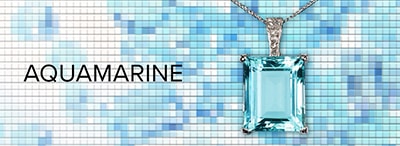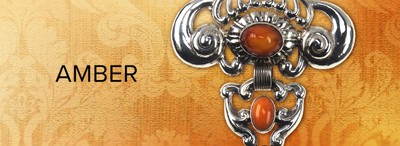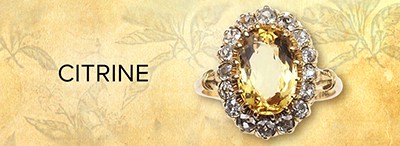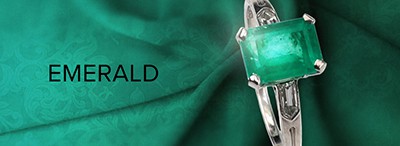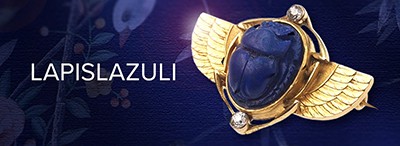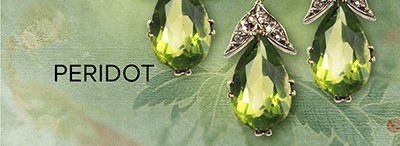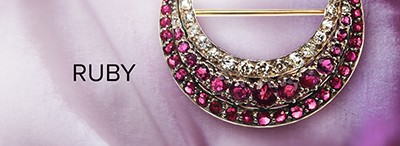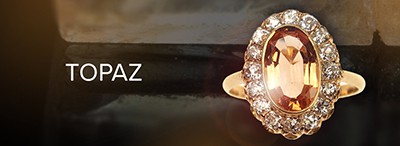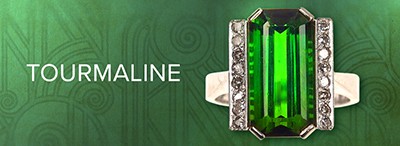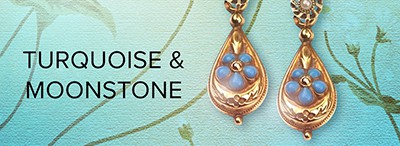Gemstones
Buy Exclusive Gemstone Jewellery – Antique Unique Pieces for Ladies & Gentlemen
Whether a diamond, rose quartz or emerald – buying and wearing gemstone jewellery inspires the senses and simply releases pure feelings of happiness. The fascination with colourful, filigree-cut natural minerals has grown steadily over the past centuries and continues unabated to this day. Which gemstone suits you best?
Discover our colour & gemstone selection:
Of course, the popularity of individual stones in past eras was sometimes subject to the influences of social circumstances. Even if today an artistically cut gemstone is beyond any stylistic doubt, as with art and fashion, a certain “trend” has always played a role in its popularity. What are the advantages of which stone?
Especially noble: The diamond
The colourless diamond, for example, has not always been the most sought-after gemstone, as it is today in its wide distribution. It was only through the development of suitably good cleaving, sawing and cutting techniques in the 19th century that the old master jewellers succeeded in significantly increasing the reflections in the diamond. This significantly increased the fascinated sensation and gave the popularity of diamonds previously unimagined boosts. The diamond symbolises indomitability, beauty and strength. The diamond is also supposed to transfer these values to the wearer, because it is supposed to give him strength of character, willpower and self-confidence. But the diamond also conveys the urge for spiritual freedom. It is a symbol of purity and is thus supposed to ensure clear thoughts. Today, the diamond is generally considered the most precious stone, closely followed by the ruby.
Colourful ruby
The ruby got its name because of its colour, which is derived from the Latin word “rubeus” (red). Previously, it was called carbuncle, which was a general term for red gemstones such as garnet, spinel or ruby in the Middle Ages. Gemstone jewellery with a ruby, always exudes a deep passion, but why is that? Mainly because of its colour red, which stands for blood, life and especially love, the stone always had a special status in ancient jewellery making. Through the ruby, wishes and desires are also supposed to return to everyday life.
Longing sapphire
The blue sapphire is closely related to the ruby. Its relatively frequent occurrence brought it widespread distribution, especially in the 20th century. It also belongs to the longing gemstones, because blue stands for distance, water and the sky. The association of the boundless expanse of the sapphire is also enchanting in the gemstone jewellery of the Victorian era in the artistic interplay with gold and diamonds. As a solitary eye-catcher, it releases longings for life and the “sea”. The name of this gemstone is derived from the Greek “sappheiros” for “blue”. There are different theories about the ultimate origin and derivation of its name, as it was already known in many ancient cultures. You know when you look at the blue sea and it has a calming effect? So the sapphire is said to provide inner peace and spiritual growth as well as clarity.
Light blue aquamarine
Emerald has a similar relationship to aquamarine as sapphire has to ruby. The colour nuances of aquamarine range from soft sea blue to intense blue with green shimmering in places. According to legend, the aquamarine comes from the treasure chest of a mermaid, which is how its name is derived, which translates as “sea water”. The aquamarine symbolises peace and can be combined well with other gemstones. A particularly popular combination of aquamarine jewellery is with white gold and platinum.
Radiant green emerald
The radiant green of the emerald is somewhat more determined than the aquamarine. The significance of the emerald is incomparably greater in ancient jewellery making all the way back to ancient Egypt! Green generally stands for hope and nature. It releases feelings of well-being just by looking at it. Emeralds worn in pendants on the skin, artfully set in gold and accompanied by pearls in the Edwardian era, for example, thus develop a fascinating pull. Some of the most beautiful engagement rings are also adorned with an emerald and are thus, like the ruby, a stone of love, hope and fidelity. The name of this gemstone probably comes from the Latin “Smaragdus”, which in turn took this name from the Greek “Smaragdos”. The emerald is considered one of the most precious gemstones and has always been highly valued in many cultures, myths and royal houses throughout human history.
Other popular jewellery gemstones:
In addition, there are other jewellery gemstones that offer a wonderful range of colour shades for ladies and gentlemen alike:
Agate
Agate has always been particularly sought after – since ancient times agate has been used to enrich art and jewellery. Especially its immense variety of colours is unique.
Opal
Gemstone jewellery with opals is always outstandingly beautiful, as these shimmering gemstones are incomparably enchanting. An opal always carries a variety of colours: the delicate fire of ruby, the violet of amethyst, the magnificent green of emerald, the warm yellow of topaz, as well as the deep blue of spahiren, so that all the colours shine together in a wonderful blend.
Peridot
The olive-green peridot was found as early as 1500 years before Christ on the island of Zebirget in the Red Sea and is suitable for everyone because of its pastel green. Especially in combination with yellow gold, peridot jewellery is an eye-catcher. Similar to aquamarine, the gemstone peridot, which sometimes appears somewhat sleepy, is surrounded by a mythical aura of friendship and the banishment of terror and resentment.
Amethyst
Hardly any gemstone is as changeable as the violet amethyst. Gemstone jewellery in as many facets and types as amethyst makes possible is rare. It is often found as a popular gemstone for necklaces and earrings.
Garnet
Garnet or the group of garnets are rock-forming minerals that occur in many varieties and are especially popular for jewellery sets. For example, they are found in the form of Bohemian garnet jewellery.
Almandine
The fiery red almandine is a popular gemstone that is often confused with the ruby, but is often used as a gemstone for earrings because of its rich facets. If you are looking for a ruby ring or a ruby necklace when buying gemstone jewellery and a corresponding specimen is not available at the moment, almandine is an excellent alternative.
Topaz
Often perceived as “smoky”, topaz is a real eye-catcher and is often used for cocktail rings. It is a stone you can wear every day, as it is beautiful but not too extravagant.
Tourmaline
Green tourmalines are often confused with emeralds, but offer an often unique shade of green that is instantly recognised by connoisseurs. Since the colour green is basically said to have a calming effect, it is ideal for an evening when you are agitated.
Citrine
Citrine got its name because of its pleasant radiant colour. It is also known as the sun stone, life stone or light stone. It is a warm yellow tone that suits every season and is therefore suitable as a piece of jewellery for every event. The citrine is also an excellent choice as a daily piece of jewellery.
Smoky quartz
Smoky quartz is a smoky brown crystal quartz that got its name because of its unique colouring. The smoky, earthy hues are very popular for necklaces or earrings. The stone makes any eye colour shine and accentuates it.
Rock crystal
The popular rock crystal convinces with its clarity and its diverse cuts. Rings with a yellow gold ring band and a small rock crystal are particularly popular. It is a classic jewellery stone that has the admirable quality of shining both as everyday jewellery and in jewellery for special occasions.
Jade
Jade, both in its green and white form, is a popular gemstone and a real eye-catcher. Green jade in particular has been used in jewellery making in rings, necklaces and brooches for over 8000 years. In Europe, jade made its entrance in the 19th century – around 1960-1970, jade was a real trend stone, for example in hippie culture.
Lapis lazuli
The blue lapis lazuli is found in antique jewellery often used as a gemstone in signet rings and convinces with a deep and uniquely rich blue tone, almost royal blue. Such an intense shade of blue really flatters everyone.
Moonstone
Moonstone is a variety of the mineral stone orthoclase and was named after its bluish-white shimmer. It is a rare and mysterious stone, which makes it so sought after in jewellery.
Turquoise
The blue-green turquoise first became known in Europe through the Crusaders and is a frequently used gemstone. Turquoise as a colour reminds us of beautiful beaches and holidays – as a piece of jewellery it is similar. Its bright colour makes us look at this gemstone for hours, as this colour is simply to dream away.
Amber
Amber is fossilised tree resin and is one of the oldest and most sought-after gemstones in the world. Amber is, as it were, a completely independent colour designation, because nothing can describe this beautiful honey-like colour, which can vary from pale milky to golden brown radiant.
Buy classic jewellery with high-quality gemstones:
Buying classic jewellery with high quality gemstones should be a rewarding act that will give you pleasure again and again by wearing the jewellery. Of course, gemstone jewellery is just as suitable as a gift for a loved one as it is for the person buying it.
A beautiful yellow gold ring with a filigree cut gemstone, is brilliantly suited for a very specific “special question”:
Engagement rings
The one question that comes from the heart should be asked with a very special ring. How perfectly does a unique antique engagement ring with a gemstone fit that bill? Exactly. It doesn’t get more beautiful than that. A diamond ring adds brilliance to the important moment of the proposal and is the classic evergreen of engagement rings.
Alongside the diamond, the ruby and the emerald have an equally fascinating clarity and are also strong and radiant in colour. The hardness of diamond, ruby and emerald makes these three gemstones ideally suited for outstanding cuts – and robust enough for everyday wear.
Gemstone jewellery usually gains radiance and dimension by having the colours of different stones complement or contrast each other. Combining coloured stones with colourless diamonds always looks particularly noble.
Order Inspiring Gemstone Jewellery at Antique Jewellery Berlin
When you buy gemstone jewellery online from Antique Jewellery Berlin, you enjoy the following advantages:
- Worldwide free and insured shipping only through the best shipping service providers, each with the best regional expertise,
- We offer all established payment options in the online shop and in our shop,
- Modifications and reworking by our three master goldsmiths are possible on request,
- Original, not embellished product photos,
- Comprehensive advice in the field of antique jewellery in German, English and Arabic: Please feel free to use our contact form for this purpose or use our chat service.
Whether you want to find the gemstone jewellery of your dreams on site in our shop (Linienstr. 44, 10119 Berlin-Mitte) or online: You can always rely on our expert service and secure checkout.
Find out more about the different types of gemstone cuts or discover stylish antique birthstone jewelry.




